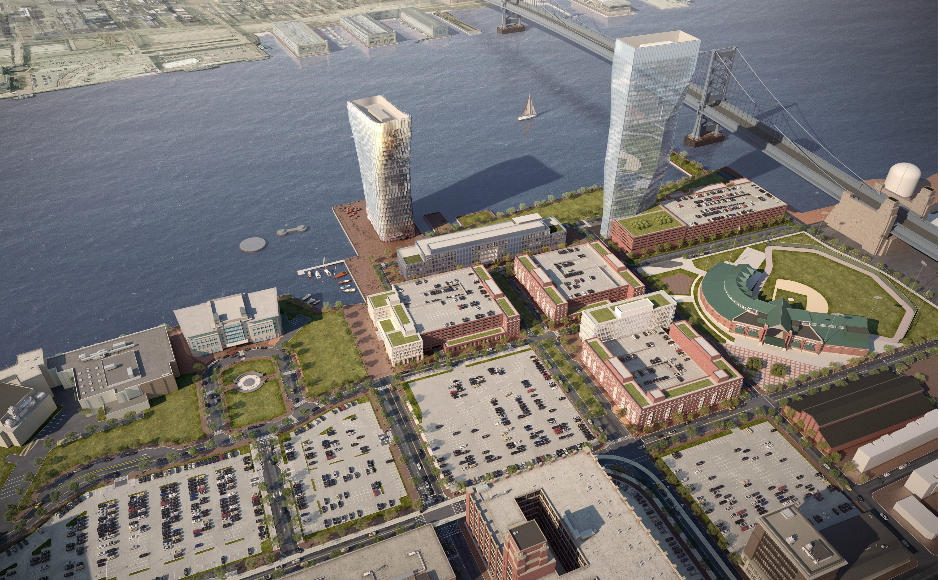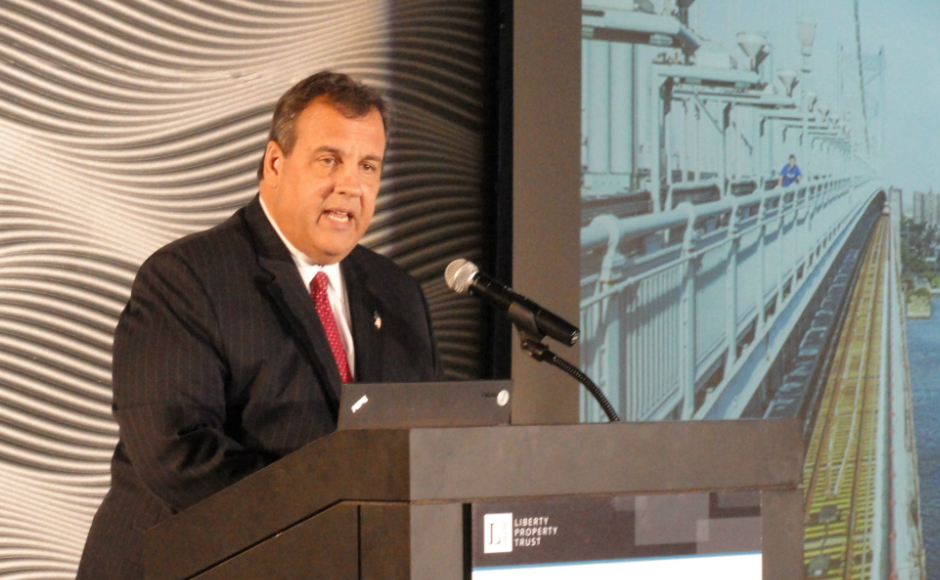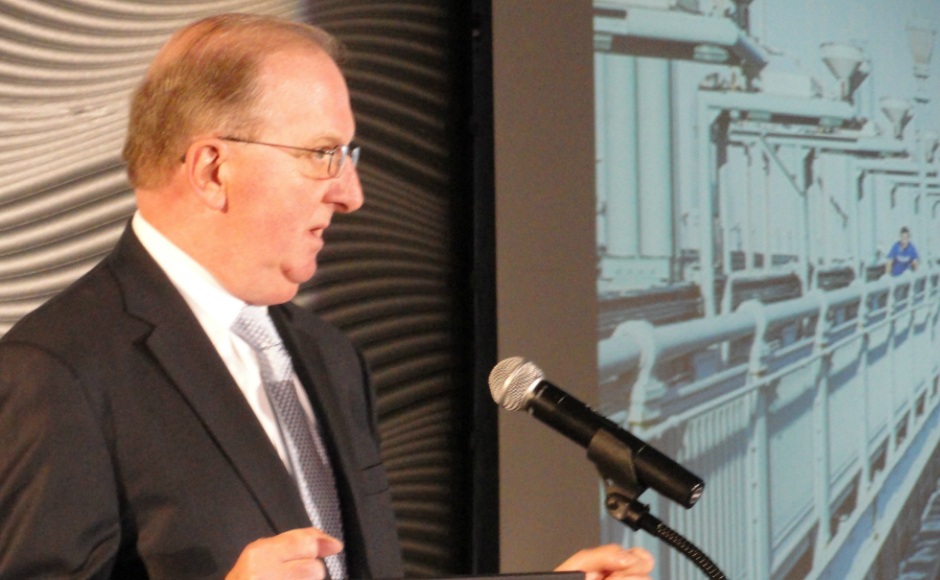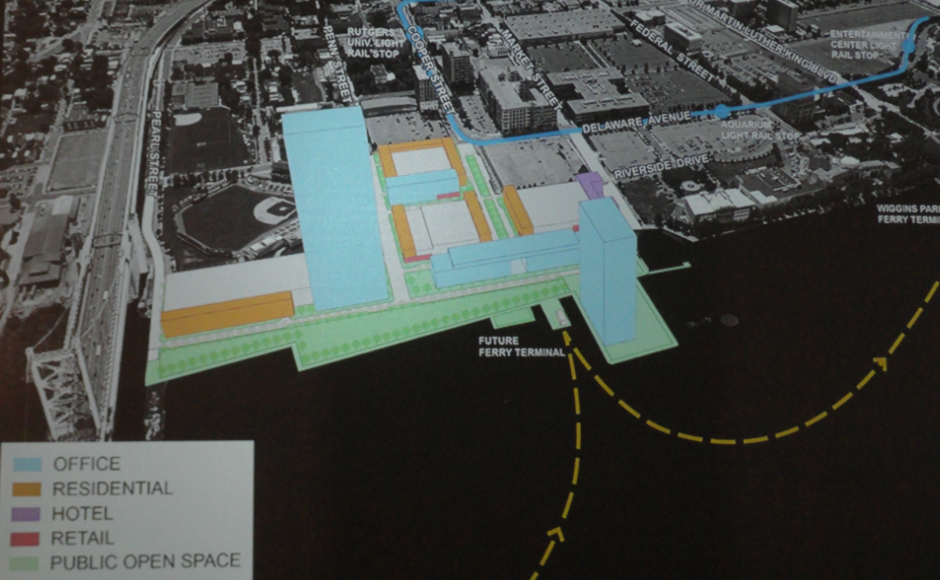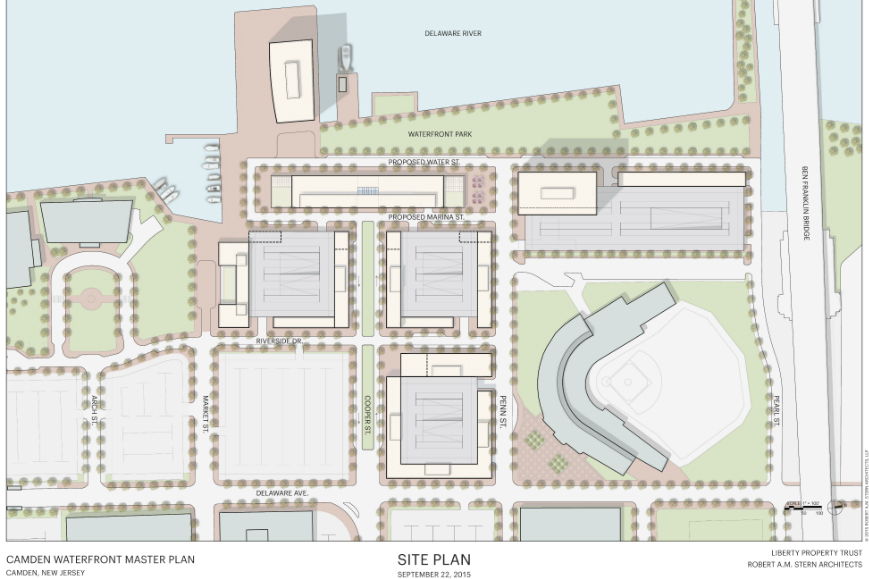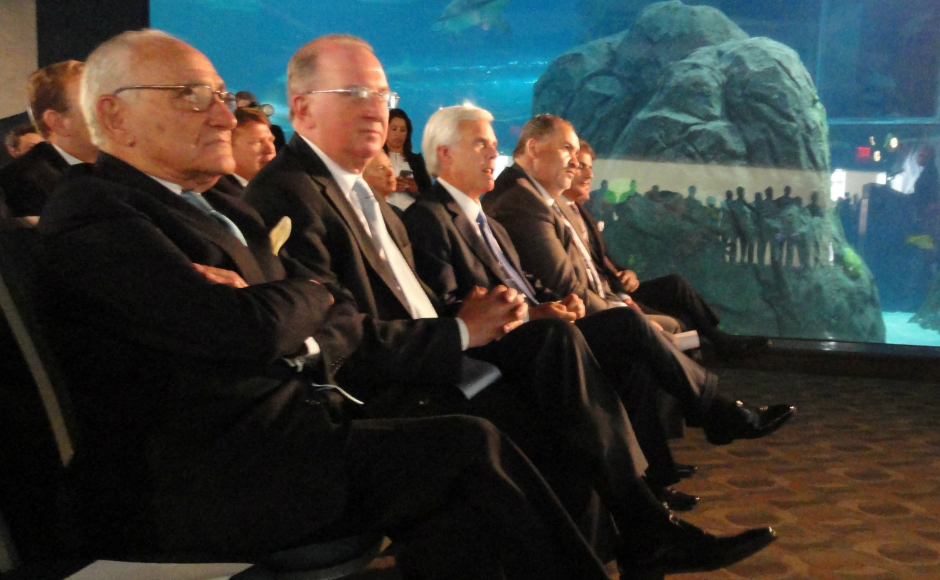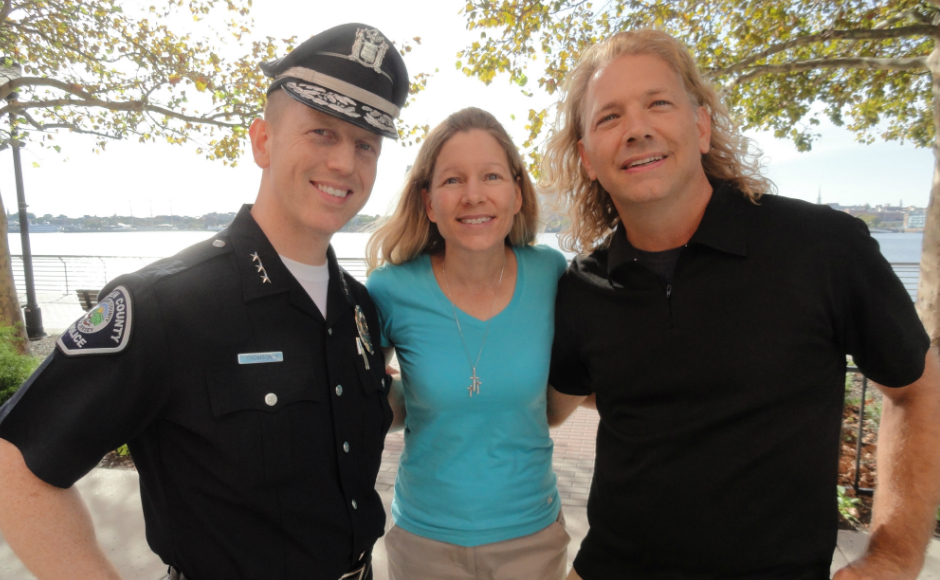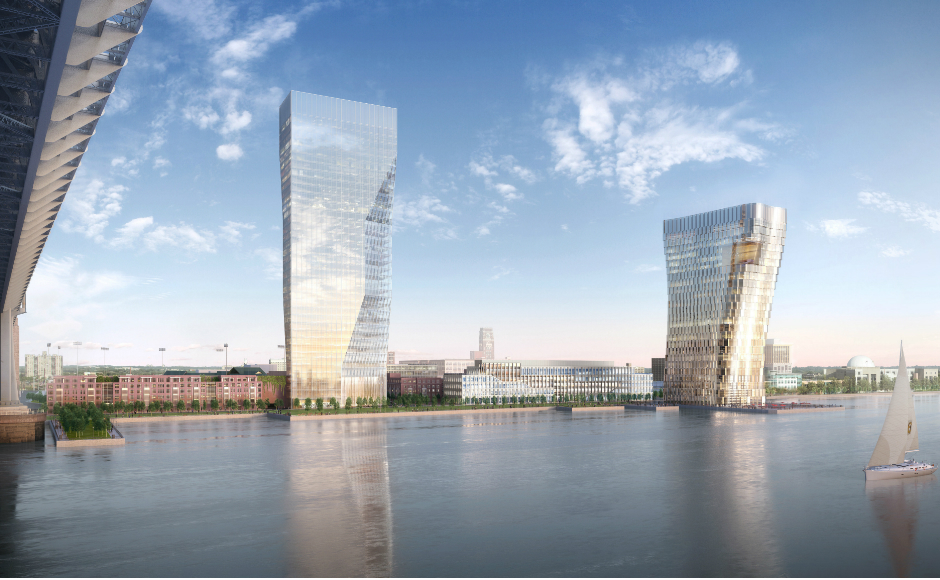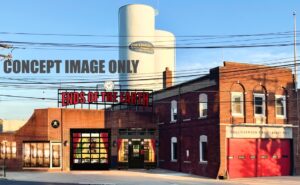Liberty Property Trust and architect Robert A.M. Stern described plans for a riverside revival that would leverage tax credits and the largest private investment in the city.
By Matt Skoufalos
Not so very long ago, New Jersey Governor Chris Christie was more famous along the Camden City waterfront for his push to bulldoze the Camden Children’s Garden than for preserving it as part of a larger redevelopment plan.
On Thursday, however, Christie personally heralded in the largest private investment in the history of the city: a $1-billion, mixed-use, neighborhood restoration project intended to transform “America’s most dangerous” community into “a place where families can come and people can do business,” he said.
“There’s going to be a time when I come here and no longer say, ‘Camden is coming back,’” Christie joked. “Camden is here.”
The man at the helm of the project, Camden City native son and Liberty Property Trust CEO William Hankowsky called Camden “a place of beginnings poised to take a starring role as a piece of the Delaware Valley metro area.”
The developer said that the momentum Camden has enjoyed, from the changeover of its police force to the Presidential visit, has made the city “a more interesting possibility for companies.” The ability “to get our hands on [16 acres of land] all at once” facilitated a project with an “eclectic mix of use” as “the glue to bring it all together.”
Hankowsky pledged that stakeholders would partner with “minority-, female-owned, and disadvantaged firms” to create and preserve jobs in the city. He was less clear on the financials of that equation, summing it up as, “we create an investment, they bring jobs.
“We’re a publicly traded company with an $800 million line of credit,” Hankowsky said.
“We’re not going to earn tax credits [for building this project]. The companies will look to that; it will allow those companies to attract their workforce.”
He also pointed out that although Liberty Property Trust is “not asking for roads, sewers, streetscapes,” the company will head into a six-month due diligence phase next, targeting a fall 2016 groundbreaking and 2019 expected completion date. That phase, at least in part, will require examining the mechanics of how all that new infrastructure would connect with some of the antiquated systems in Camden.
Twin cities, revisited
Robert A. M. Stern, the same man who designed Philadelphia’s Comcast Center for Liberty Property Trust, is also the architect of the project in Camden.
On Thursday, he described it as “the most exciting urban site I have ever had the privilege to work on.”
At its center, Stern showed renderings of two “strong and iconic towers” that would frame the Camden shores and “sparkle” along the Delaware River while providing a point of reference to pair Camden with the city on the other side.
“People don’t think of Philadelphia and Camden as being connected,” Stern said, but after the project is completed, he said, “we’ll be able to shake the right kind of fist at big brother across the river.”
Although the focus of the development could easily become those towers, Stern took care to point out that Liberty Property Trust more accurately is creating “a new, mixed-use neighborhood” at the edge of the Delaware, one that would “connect, maybe for the first time, the city to the waterfront, visually and literally.”
“Public open space is key to the success,” he said. “Streets form gateways to the river so it’s not just a bunch of buildings and parking lots,” which presently isolate users from the experiences of amenities like Campbell’s Field, the Adventure Aquarium, or the Susquehanna Bank Center.
“I hope that what we’re doing will give those attractions a new focus,” Stern said.
The project encompasses 1.7-million square-feet of real estate, 352,000 of which will include 325 housing units “facing, supporting, [and] participating in street life,” Stern said, plus another 27,000 square-feet of retail space, and a hotel. Public transportation in the area “is excellent, and will improve with [the addition of] a [cross-Delaware] ferry,” Stern said, adding that the location enjoys a “rich [cultural] fabric nearby” and is “surrounded by academic use.
“Kids don’t spend any money but they look really good on the streets,” he joked. “We want people who’ll come out, walk down the street, buy a pint, stay and have dinner.”
Building a coalition
Few individuals are as personally connected to the ongoing redevelopment efforts in Camden as George Norcross, and not just because he has personally pledged to back the waterfront project with $50 million of his own money.
The executive chairman of insurance and risk management broker Conner Strong & Buckelew, Norcross is also the Chairman of the Board of Trustees of Camden’s Cooper Health System and serves on the Board of Trustees for Holtec International, the energy firm that will build its new tech campus in the city in exchange for $260 million in tax credits.
In a city where more than half the taxpayers are off the rolls, employers that offer “a consistent and constant revenue stream” are needed, Norcross said, and so along with Conner Strong, he marshaled Cherry Hill logistics firm NFI, Marlton builders the Michaels Organization, and the Haddonfield law firm of Archer & Greiner, PC to back the Liberty Property Trust project.
“In order to get true believers in Camden, I had to demonstrate my commitment,” Norcross said, chatting after the presentation. “I went to them with a pitch. I’m putting my money where my mouth is.”
“The intent of the project is to gather folks that are willing to relocate to the city,” he said—aided in no small part by the Grow NJ Assistance Program, which he called “an enormous catalyst in the city.”
Administered by the New Jersey Economic Development Authority, the program provides annual tax credits from $500 to $5,000 per job created or retained in the state, with annual bonus credits ranging from $250 to $3,000 per job.
“There will be a time when businesses will relocate on their own to the city,” Norcross said.
In the meantime, he added, property values have quadrupled in value around land occupied by Cooper Health System and Rutgers University thanks to the work those institutions do to preserve public safety in the surrounding neighborhoods. Norcross described the massive waterfront reshaping as taking back a significant portion of the community at once.
“Where things have failed in the past is that they did not focus primarily or exclusively [on providing public safety and public education] in the neighborhoods,” he said. “A couple years ago, you could buy drugs a block from here, or get murdered, or buy sex,” he said, indicating the aquarium.
“Too many things were proposed in the past 30 years that were show pieces. They didn’t spur any economic development.”
Creating momentum
Artist William Butler, whose Gallery Eleven One studio has operated for four years in a renovated firehouse around the corner from where the announcement was made, said after the meeting that he believes the plan has the potential to improve conditions in the surrounding neighborhoods.
“I love the hopes of new economic development when it includes community, and bridges marketplace and residential [sites],” Butler said. “You hope everybody gets uplifted by development.”
Butler’s remarks underscored those of New Jersey NAACP President Richard T. Smith, who at the podium told the crowd, “When businesses and communities flourish, unemployment declines, hope abounds, and, for some who have lost it, it rebounds.
“The welfare of our society is dependent upon its component parts [and] creating jobs for Camden’s residents are just the first steps for this city,” Smith said.
After the presentation, Camden County Police Chief J. Scott Thomson echoed those sentiments.
“This will create a momentum in and of itself,” Thomson said; “help change the narrative that’s been negatively affecting our city for decades.”
Quoting urbanist Joel Kotkin, Thomson said that Camden, like any city, needs to be “safe, sacred, and busy.” The man tasked with providing that safety said the people of the city make it sacred, but that improving their economic opportunities will make it busier.
“That’s [at] the center of a great city,” the chief said. “That will come from this project. We went from ‘Apocalypse New Jersey’ in Rolling Stone to ‘it’s open for investment.’”
When asked how a billion-dollar waterfront overhaul will translate into something that helps improve the beleaguered neighborhoods much farther out from the epicenter of such redevelopment, Thomson sounded a lot like Stern in describing the visual promise that the glass and steel towers would radiate.
“You will be able to see these buildings from every part of our city,” he said. “If a kid wants to have a Wall Street-like experience, he can walk a couple blocks.
“Hopefully it’s the beginning,” he said. “No reason it can’t continue outward.”

